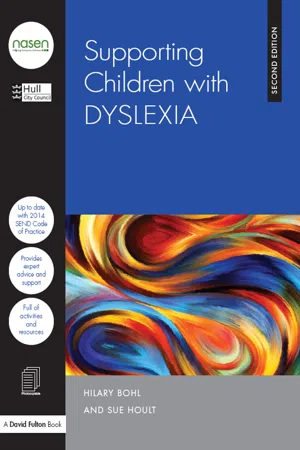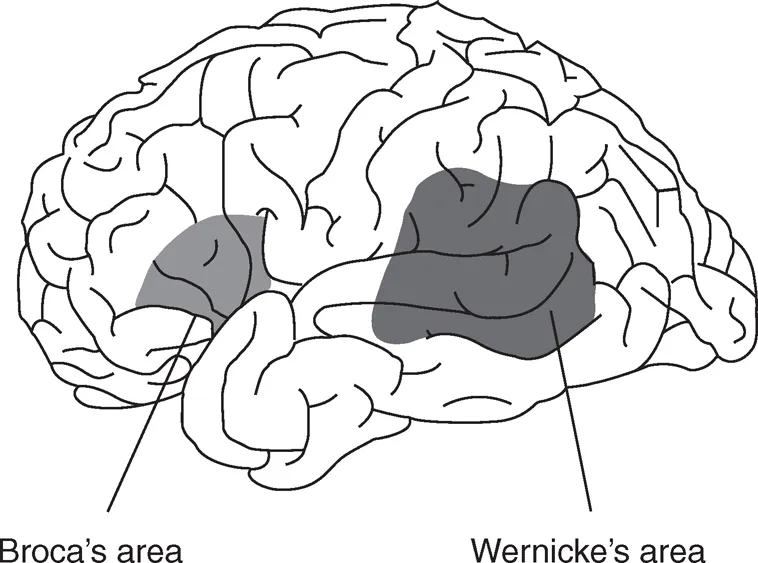
- 138 pages
- English
- ePUB (mobile friendly)
- Available on iOS & Android
Supporting Children with Dyslexia
About this book
Completely revised and updated in light of the new 2014 SEND Code of Practice, this second edition of Supporting Children with Dyslexia provides valuable advice and resources for teachers, TAs and SENCOs supporting pupils on the dyslexic spectrum. This practical resource will help those who are looking for expert guidance and strategies, as well as providing a professional development tool which will encourage outstanding practice at all levels.
Spanning pre-school, primary and secondary teaching, this book covers the key areas to be considered when supporting pupils with dyslexia, including:
- how to identify a young person with dyslexia
- practical strategies for pre-school, primary and secondary settings
- useful advice to give to parents and carers of children and young people with dyslexia
- useful materials for continual professional development
Featuring helpful checklists, templates and photocopiable resources, this book provides guidance and practical strategies for identifying and supporting young people with dyslexia that will be of use to teachers, TAs, SENCOs and other educational professionals.
Frequently asked questions
- Essential is ideal for learners and professionals who enjoy exploring a wide range of subjects. Access the Essential Library with 800,000+ trusted titles and best-sellers across business, personal growth, and the humanities. Includes unlimited reading time and Standard Read Aloud voice.
- Complete: Perfect for advanced learners and researchers needing full, unrestricted access. Unlock 1.4M+ books across hundreds of subjects, including academic and specialized titles. The Complete Plan also includes advanced features like Premium Read Aloud and Research Assistant.
Please note we cannot support devices running on iOS 13 and Android 7 or earlier. Learn more about using the app.
Information
Part I Background information
1 What is dyslexia?
I don’t ‘suffer’ from dyslexia. I live with it and work with it. I suffer from the ignorance of people who think they know what I can and cannot do.Erica Cook (Mountain Learning Ally member, Learning Systems)
- Dyslexia is a hidden disability thought to affect around 10% of the population, 4% severely.
- Dyslexia is usually hereditary.
- A pupil with dyslexia may mix up letters within words and words within sentences while reading.
- They may have difficulty with spelling words correctly when writing; letter reversals are common.
- Dyslexia is not only about literacy.
- Dyslexia affects the way information is processed, stored and retrieved with problems of memory, speed of processing, time perception, organisation and sequencing.
- Dyslexia can also affect navigating a route, left and right and compass directions.
A video for explaining dyslexia
The DFE definition of dyslexia
Dyslexia is a learning difficulty that primarily affects the skills involved in accurate and fluent word reading and spelling.
- Characteristic features of dyslexia are difficulties in phonological awareness, verbal memory and verbal processing speed.
- Dyslexia occurs across the range of intellectual abilities.
- It is best thought of as a continuum, not a distinct category, and there are no clear cut-off points.
- Co-occurring difficulties may be seen in aspects of language, motor co-ordination, mental calculation, concentration and personal organisation, but these are not, by themselves, markers of dyslexia.
- A good indication of the severity and persistence of dyslexic difficulties can be gained by examining how the individual responds or has responded to well-founded intervention.
(Rose Review, 2009)
A brief history of what people have understood dyslexia to be
The medical perspective: a pathological condition (the visual theories of dyslexia/acquired dyslexia)
- 1878 Dr Kussmaul, a German neurologist, described patients he was treating as having ‘reading blindness’.
- 1891 Dr Dejerne reported in The Lancet that people who had a reading difficulty had probably suffered a brain injury.
- 1895 Dr Hinshelwood concluded the cause of a reading difficulty was a malfunction of eyesight as a result of a brain defect.
- 1925 Dr Orton proposed an idea that dyslexics had a deficient visual perception of letters, possibly due to a brain malfunction. He called it ‘strepthosymbolia’ (twisted symbols).
- 1936 Gillingham worked with Orton and together with Stillman published a phonic-based, visual, auditory and kinesthetic approach to the teaching of reading. Most dyslexia specialist teachers today use the multi-sensory methods pioneered by this approach. It has its supporters and critics.
- 1971 Lieberman’s research, amongst others, challenged Orton’s theory of dyslexia as a visual problem. He felt the major problem was with phonological processing.
The transition to an educational psychological perspective
- 1978 The Warnock Report into children with SEN stimulated the change that children with specific learning difficulties (SpLD) were no longer considered to be under the jurisdiction of medicine. The role of the educational psychologist began to develop.
- 1979 Frank Vellutino, amongst others, suggested that studies showed that dyslexics had problems with verbal rather than visual functions.
- 1981 The Education Act advocated dyslexia come under the description of specific learning difficulty.
- 1989 Galaburda found that people diagnosed as dyslexic had a superior development of the right hemisphere of the brain. A view that maybe dyslexia was a normal variation of brain development and not a disorder.
- 1994 SEN Code of Practice officially recognised dyslexia for the first time, although it came under the umbrella of specific learning difficulties.
- 1995 dyslexia was recognised under the Disability Discrimination Act.
A neurological basis for dyslexia
- 1996 National Institute of Mental Health team in USA identified regions of the brain that worked differently in people who have dyslexia.
- 1997 SEN Code of Practice mentioned dyslexia as an example of SEN in its own right.
- 2002 Reseachers at Yale University used FMRI technology to show that the brains of children with dyslexia worked differently from their peers during reading tasks.
- 2005 Yale University team identified a gene associated with dyslexia.
- 2007 Researchers at University College London used brain imaging to identify the area of the brain that does not work as effectively in people with dyscalculia.
- 2012 Hornikel and Kraus in the Journal of Neuroscience stated that dyslexia is primarily an auditory disorder that arises from the inability to respond to speech sounds in a consistent manner.
- 2014 Research by Finn et al. at Yale showed that this underlying problem with perception of speech sounds, in turn, affects the development of brain networks that enables a pupil to link a speech sound to the written letter.
Did you know dyslexia is recognised as a disability?
We need to make sure dyslexia is clearly understood and recognised as a disability in the terms of the Equality Act 2010.Children and Families Minister Edward Timpson, 2012
2 What causes dyslexia?
A dyslexic person is predominantly using the right hemisphere of their brain instead of their left to read and spell.

A brain-based problem in the decoding of written language.

Phonological processing impairment theory
Wiring of the brain

Table of contents
- Cover Page
- Half Title Page
- Frontmatter
- Title Page
- Copyright Page
- Table of Contents
- About the authors
- Preface
- PART I Background information
- PART II Dyslexia toolkit for schools
- PART III Continuing professional development materials
- Appendix 1: Pupil profile form
- Appendix 2: Common exception words bump game for spelling
- Appendix 3: Guide to apps for dyslexia
- Appendix 4: Mnemonic techniques for spelling CEWs
- Appendix 5: Guide to spelling rules
- Appendix 6: Thai alphabet activity
- Appendix 7: Dyslexia-friendly classrooms: getting started
- Appendix 8: Where to find out further information on dyslexia
- Bibliography